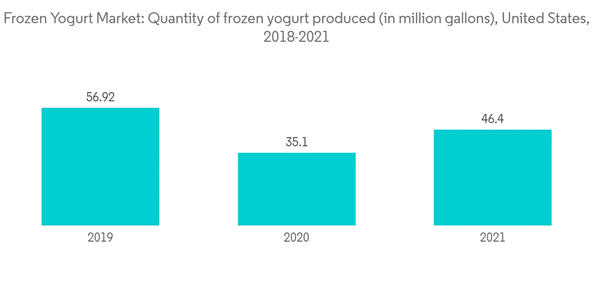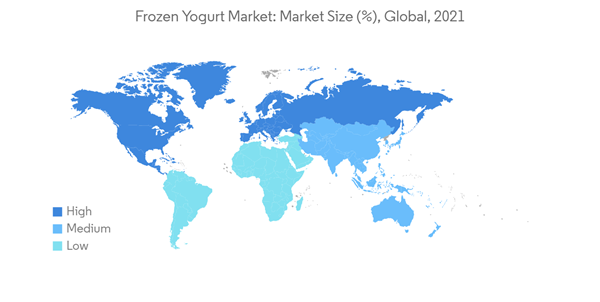The Frozen Yogurt Market size is estimated at USD 1.05 billion in 2024, and is expected to reach USD 1.40 billion by 2029, growing at a CAGR of 5.97% during the forecast period (2024-2029).
This product will be delivered within 2 business days.
Key Highlights
- The frozen yogurt market is experiencing rapid growth due to global demand for tart-flavored desserts and the rising consumption of frozen yogurt. Growing demand for healthy foods is also present among young consumers, contributing to the industry's growth. According to the US Department of Agriculture, the United States' per capita consumption of frozen yogurt increased to 0.9 pounds in 2021, an increase from 0.6 pounds in 2020.
- Furthermore, consumers are increasingly interested in immune boosters and fortified products that have health benefits, so major players have improvised their yogurt products by adding organic ingredients, making them cholesterol-free, and creating vegan variants. For instance, in July 2021, Oatly launched a plant-based vegan frozen yogurt available across the United States.
- Over the medium term, increased consumer preference for non-dairy, low-calorie, high-protein, and healthier desserts is the primary factor driving the market. Additionally, the rising popularity of low-fat frozen yogurt and the introduction of beneficial product variants with various flavors is likely to provide numerous options for consumers looking for a healthy alternative to frozen desserts.
- Furthermore, hectic lifestyles and health and wellness concerns drive consumers towards opting for convenient frozen dessert-based snacks and frozen yogurt as meal replacements. Moreover, major players are trying to stabilize their position in the market by focusing on e-commerce and online marketing to reach out to consumers beyond geographical barriers, which is driving the growth of the frozen yogurt market.
Frozen Yogurt Market Trends
Growing Preference for New Flavors and Low-Calorie Variants
- Consumers look for frozen yogurt in convenient packings, such as bars and cups, with consumer-preferred flavors. Flavors and combinations that are unique are becoming increasingly popular. Frozen yogurt tastes such as savory, caramel, chocolate, and fruity are in high demand. The rising demand for natural label claims is still driving the market.
- Tart flavors have gained appeal in recent years, competing with typical sweet flavors. To boost sales, frozen yogurt brands are developing new flavors and bar-style products. For instance, in July 2022, Pinkberry, a frozen yogurt shop based in Arizona, launched a new frozen yogurt and smoothie called Lava Swirl. A combination of strawberries, pineapple, and tropical coconut flavors produces the Lava Swirl.
- Additionally, as consumer habits change around the world, consumers are becoming more prone to adopting and consuming dairy foods that are healthy, tasty, organic, and low in calories to meet their nutritional needs. Hence, due to the rising consumer preference for low-calorie products, yogurt with non-fat and low-fat flavors are gaining popularity.
- Ice cream consumers are becoming more attracted to flavored frozen yogurt since it contains probiotics that help with digestion, appearance, and weight loss. As a result, the players are expanding their manufacturing facilities to keep up with the growing demand for frozen yogurt.
North America Continues to Dominate the Global Frozen Yogurt Market
- The frozen yogurt industry in North America is predicted to grow in the coming years, owing to the popularity of healthier food options and its image as an available dessert. While frozen yogurt's popularity has grown in the United States and Canada, Mexico is predicted to be an attractive market for both set yogurt and frozen yogurt during the projection period, with a significant growth rate.
- The market for frozen yogurt is expected to grow at a higher rate than set yogurt, primarily because of the emergence of frozen yogurt as a dessert category and its pro-biotic nature, which is good for health.
- Furthermore, the United States holds a significant share of North America. There is a substantial shift in consumer preferences from dairy-based frozen yogurt to non-dairy-based frozen yogurt products, especially among high-income consumers.
- Manufacturers with high consumer insights, capabilities, and best-in-class product development competencies are attracting more consumers through innovative product portfolios. For instance, in June 2022, The chewy candy company HI-CHEW partnered with Menchie's Frozen Yogurt in North America to launch a limited edition HI-CHEWTM Rainbow Sherbet Flavor frozen yogurt.
- The presence of frozen yogurt in numerous flavors offered by both local and significant players, with promising health benefits and exceptional flavor experience, is also driving the sales of frozen yogurt in the region.
Frozen Yogurt Industry Overview
The global frozen yogurt market is competitive, with major multi-national players like General Mills Inc., Danone, Unilever, and Nestle dominating the market and multiple regional players responsible for splitting the market share of these key players. Major players have focused on long-term strategies involving product and flavor innovation as the market demand is shifting toward new flavors, apart from mergers & acquisitions. The competition among the players is high as there are many providers of frozen yogurt.Additional Benefits:
- The market estimate (ME) sheet in Excel format
- 3 months of analyst support
This product will be delivered within 2 business days.
Table of Contents
1 INTRODUCTION
4 MARKET DYNAMICS
5 MARKET SEGMENTATION
6 COMPETITIVE LANDSCAPE
Companies Mentioned (Partial List)
A selection of companies mentioned in this report includes, but is not limited to:
- General Mills Inc.
- Danone S.A.
- Nestlé S.A.
- Unilever PLC
- Yasso Frozen Greek Yogurt
- Dairy Farmers of America Inc.
- Groupe Lactalis SA
- HP Hood LLC.
- Sovos Brands Intermediate, Inc.
- Bulla Dairy Foods
- Turkey Hill Dairy
- Wells Enterprises
Methodology

LOADING...










